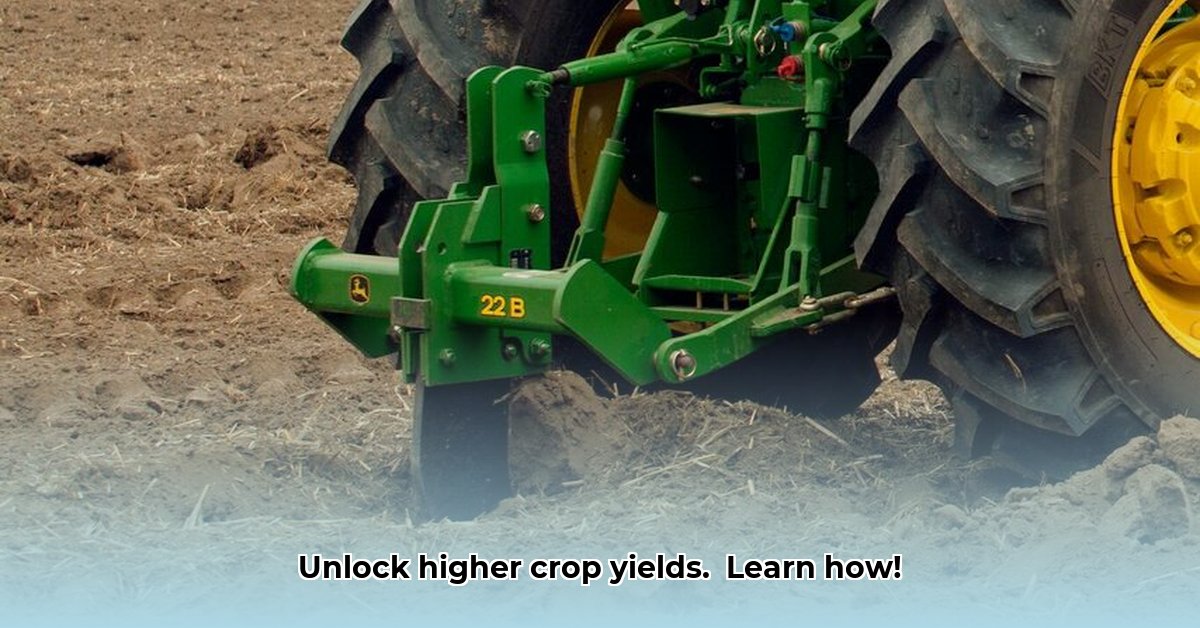
Understanding Soil Compaction and its Impact on Crop Yields
Hard, compacted soil acts as a barrier to plant growth, restricting root development and hindering water and nutrient uptake. This leads to stunted plants and reduced yields. Think of it like trying to grow a plant in a concrete pot—it simply won't thrive. Soil compaction is often caused by heavy machinery, repeated tillage, or natural processes. But there's a solution: soil ripping. For more information on tractors and seeding equipment, check out this helpful resource.
Types of Soil Rippers: Choosing the Right Tool for Your Farm
Several types of rippers are available, each designed for specific soil conditions and farm sizes. The right choice depends on your unique circumstances and goals.
Single-Shank Rippers
- Description: These rippers feature a single shank (a strong, pointed metal tine) that penetrates compacted soil.
- Best For: Smaller farms, targeted compaction issues, areas with obstructions. They offer precision and maneuverability.
- Pros: Affordable, easy to maneuver, precise soil penetration.
- Cons: Slower coverage compared to multi-shank rippers, less efficient for large fields.
Multi-Shank Rippers
- Description: These rippers utilize multiple shanks, allowing for faster coverage of larger areas.
- Best For: Large farms, widespread compaction, efficient and rapid soil loosening.
- Pros: Fast coverage of large areas, highly efficient for large-scale operations.
- Cons: Higher initial cost, requires a more powerful tractor, higher maintenance needs.
Variable Shank Design Rippers
- Description: Offer the most flexibility, adaptable to various soil conditions and compaction levels. Shank depth and intensity can often be individually adjusted.
- Best For: Fields with varying soil conditions and compaction levels needing a precise, tailored approach.
- Pros: Adaptable to different soil types, can target specific areas with greater intensity, high degree of precision.
- Cons: More complex operation, potentially higher initial and maintenance costs.
Isn't it fascinating how much variation exists in seemingly simple agricultural machinery? The right choice drastically impacts efficiency and long-term soil health.
Selecting Your Perfect Ripper: A Step-by-Step Guide
Choosing the right ripper is crucial for maximizing your return on investment. Follow these steps for a successful selection:
- Assess Your Soil: Conduct a thorough soil test to determine type, compaction level, and moisture content. This data is fundamental.
- Consider Your Tractor's Horsepower: Ensure your tractor has sufficient power to pull the chosen ripper without strain. Underpowering is risky business, leading to equipment damage and inefficiency. A simple calculation using your tractor's specifications and the ripper's requirements is essential.
- Evaluate Your Field Size and Layout: The size of your fields directly impacts the type of ripper needed. Larger fields often benefit from multi-shank designs for efficiency. Fields with obstacles might necessitate single-shank rippers for maneuverability.
- Set a Realistic Budget: Rippers vary greatly in price. Factor in all potential costs, including maintenance and repairs, to ensure a sound financial decision.
- Define Your Precision Needs: Assess whether you need precise, targeted tillage or broader, faster coverage. This directly influences the choice of ripper and shank type.
Operating a Ripper: Safety and Best Practices
Safe and effective operation is paramount. Adhere to these best practices:
- Set the Correct Depth: Adjust depth based on your soil analysis. Over-ripping can damage soil structure and has negative long-term impacts on yield. Shallow ripping may be ineffective.
- Maintain a Consistent Speed: Keep a steady pace to ensure even tillage. Erratic speeds lead to uneven soil penetration.
- Regular Maintenance: Regular inspections and maintenance are crucial to prevent downtime and extend the life of your ripper. This prevents unexpected breakdowns and ensures reliable performance.
- Prioritize Safety: Always wear appropriate safety gear, including eye protection and hearing protection. Follow the manufacturer's operating instructions meticulously.
Do you know that regular maintenance can increase the lifespan of your ripper by as much as 25% – significantly impacting your long-term savings?
Integrating Rippers into a Sustainable Soil Management Plan
Ripping should be part of a comprehensive soil management strategy. Combining ripping with other sustainable practices optimizes soil health and crop yields.
- Cover Cropping: Planting cover crops after ripping protects the soil from erosion and improves its health.
- No-Till Farming: Ripping can be integrated into no-till farming systems to address localized compaction issues without extensive soil disturbance.
Long-Term Considerations: Return on Investment and Environmental Impact
While the initial investment in a ripper can be substantial, the long-term benefits often outweigh the costs. Increased yields, reduced reliance on chemical inputs, and improved soil health contribute to a strong return on investment. However, responsible use is essential. Monitor soil health indicators, minimize soil erosion, and consider the energy consumption of your operations to ensure environmental sustainability.
Conclusion: Ripping Your Way to a Healthier Farm
Choosing the right ripper tractor is a significant step toward improving soil health, increasing crop yields, and building a more sustainable farming operation. By following the guidelines outlined in this guide, you can make an informed decision that will benefit your farm for years to come. Remember, healthy soil is the foundation of successful farming.